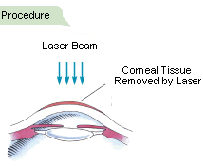PRK is an abbreviation for photorefractive keratectomy, a procedure, during which the surface of the cornea (the outer surface of the eye) is flattened by the ophthalmologist with the help of a special excimer laser. This procedure is used to correct refraction errors, such as nearsightedness (myopia), farsightedness (hyperopia), and astigmatism. This type of laser eye surgery helps people to reduce their dependency on glasses and/or contact lenses.
PRK surgery
 PRK (photorefractive keratectomy). This method is performed with an excimer laser, which uses a cool ultraviolet light beam to precisely remove ("ablate") very tiny bits of tissue from the surface of the cornea in order to reshape it. When you reshape the cornea in the right way, it works better to focus light into the eye and onto the retina, providing clearer vision than before.This laser will remove only a small piese of the thickness of cornea tissue. PRK also is often used to correct light nearsightedness. While the procedure is perfomed the outer part of the cornea (epithelium) is removed. Patient may feel a little more discomfort after the procedure also a longer healing time compare to a Lasik procedure.
PRK (photorefractive keratectomy). This method is performed with an excimer laser, which uses a cool ultraviolet light beam to precisely remove ("ablate") very tiny bits of tissue from the surface of the cornea in order to reshape it. When you reshape the cornea in the right way, it works better to focus light into the eye and onto the retina, providing clearer vision than before.This laser will remove only a small piese of the thickness of cornea tissue. PRK also is often used to correct light nearsightedness. While the procedure is perfomed the outer part of the cornea (epithelium) is removed. Patient may feel a little more discomfort after the procedure also a longer healing time compare to a Lasik procedure.
The best candidates for PRK
Even though the PRK procedure is very convenient, since the person does not have to wear external devices to correct their vision, not everyone is eligible for this type of surgery. People should fulfill these requirements in order to be able to undergo this type of laser eye procedure:
- Should have healthy eyes
- Be 21 years old or older
- Stable refraction error
- Myopia should be from -1.5 to -7.0 diameters
- Should be physically healthy
- Have realistic expectations about the surgery
PRK eye surgery
PRK eye surgery is performed under local anesthesia. Anesthetic drops are applied on the eyes prior to the procedure, so that the surface of the eyes is numb and insensitive to the intervention. The computer then drives the laser automatically, according to the patient’s refraction error. The laser beam burns off (ablates) a certain amount of the central part of corneal stroma, just below the epithelium. This changes the shape of the cornea and, hence, the refraction error is corrected meaning that a patient has no longer to wear glasses or contact lenses. A surgeon places a bandage lens in order for the eye to heal safely.
The recovery period takes up to six months, during which a patient requires to use eye drops to help the healing of the eye.
Advantages:
-
The procedure is painless;
-
Short-time surgery;
-
Effective;
-
The stability of results.
-
PRK laser eye surgery cost less than LASIK
Possible complications
Although photorefractive keratectomy is considered to be a safe laser eye surgery and complications are rare, like any surgery it may have certain complications. The healing period after this type of surgical procedure is very long and longer, compared to LASIK. Some patients may experience pain, glare, halos, or starburst aberrations. Nearsightedness may reoccur after the PRK procedure. There is a risk of increased intraocular pressure. Corneal haze and scarring may occur following photorefractive keratectomy. Some patients complain that their best corrected visual acuity is lower after the procedure.